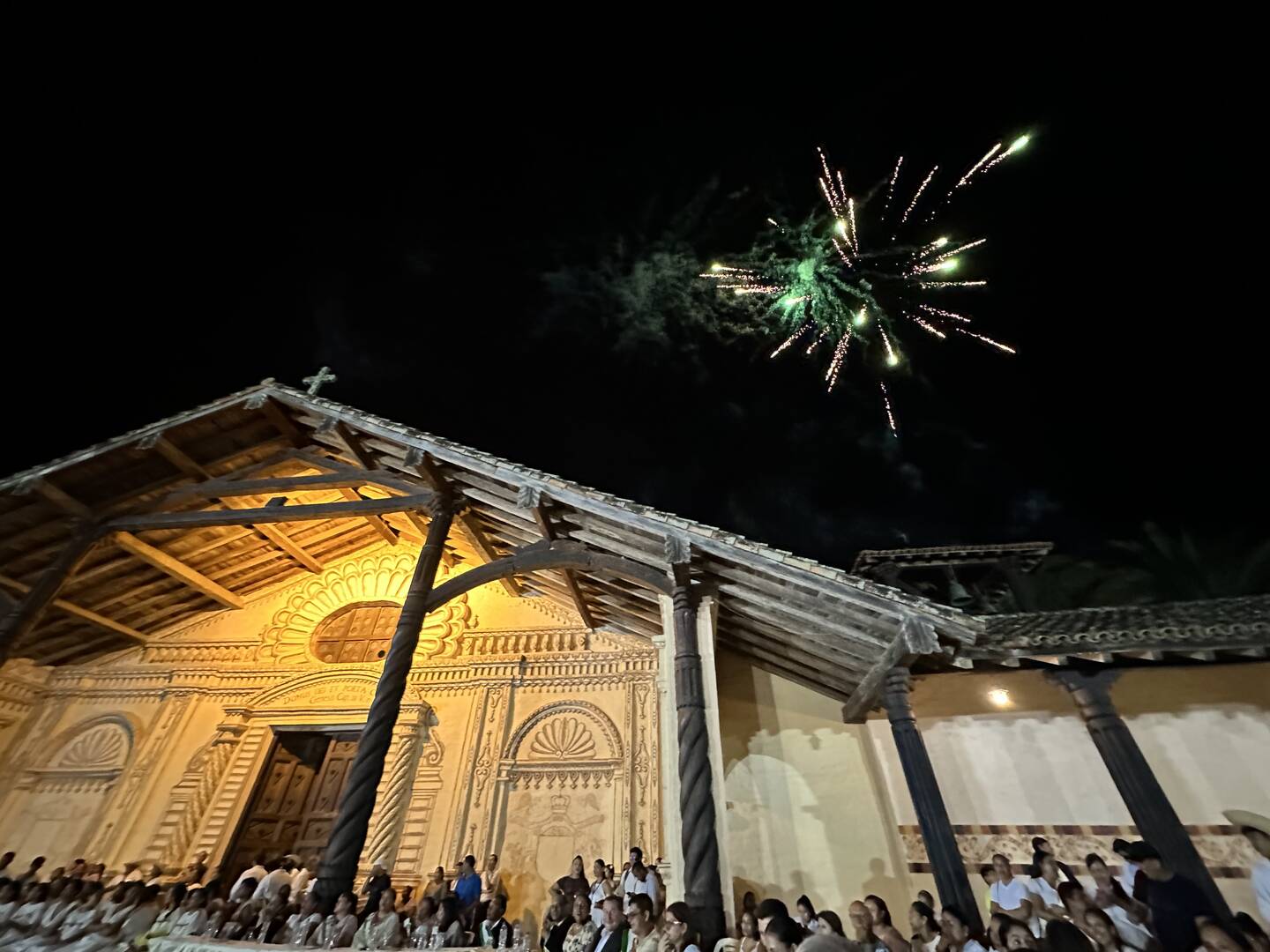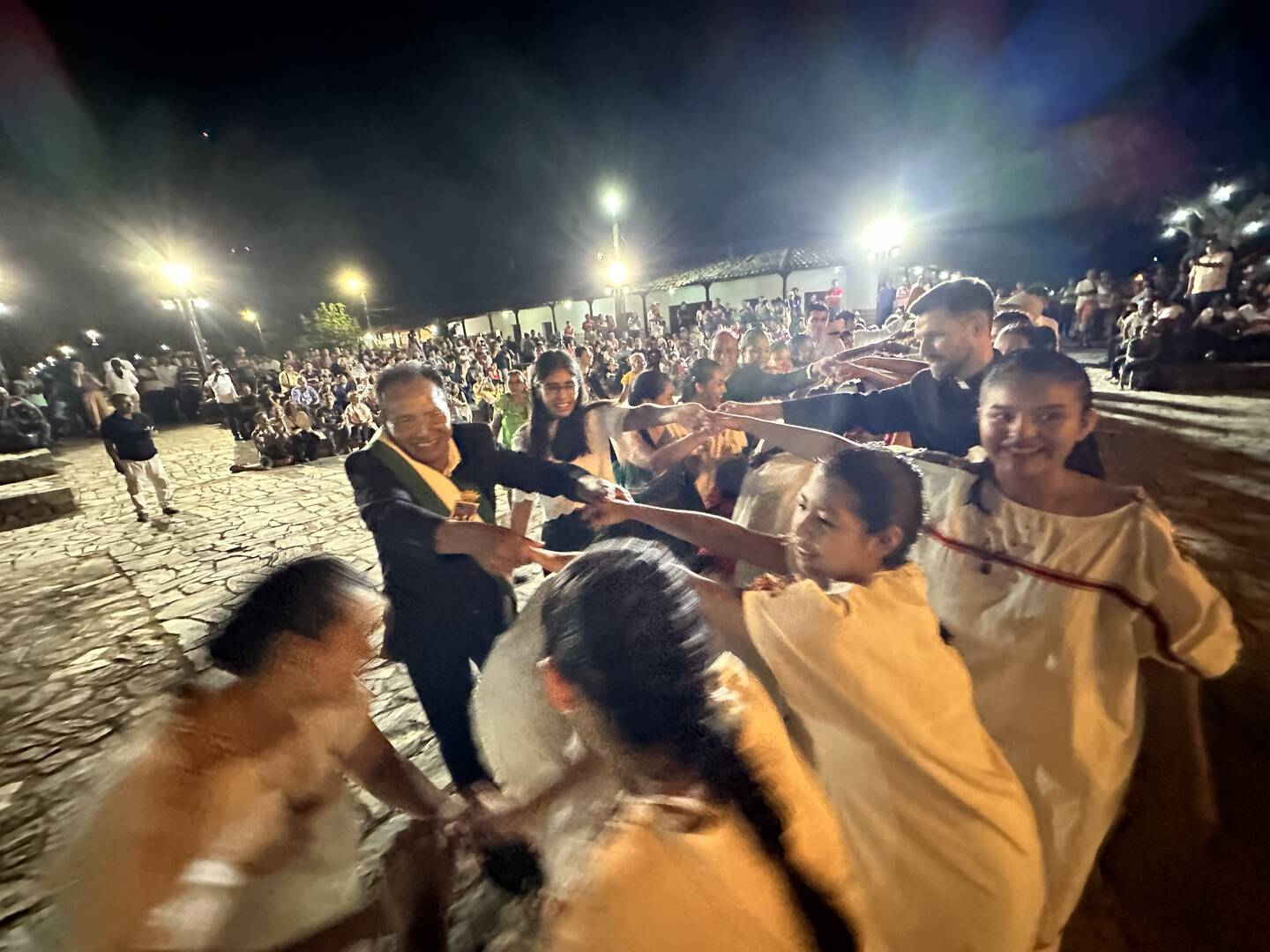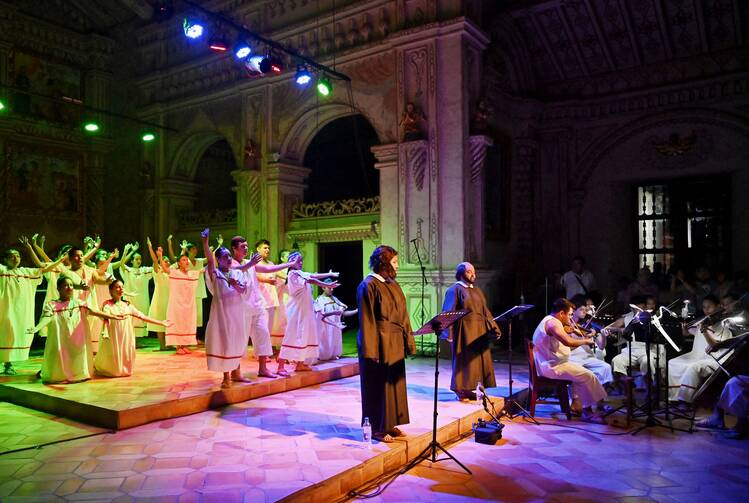To accommodate the anticipated overflow crowd in the town of San Javier, Bolivia, Mayor Dany Montalvan blocked the streets surrounding its church, San Xavier.
The space was simply not big enough for the public as local residents and international visitors—led by losyarituses (dancers portraying sacred birds)—processed, funneled, then eventually squeezed their way into the church for the premiere of the restored opera “San Francisco Xavier” on April 23.
The opera lasted only 45 minutes, but in theater-speak, it was the first of a three-act production that evening. Act II started after the opera concluded, as Mayor Montalvan and local civic leaders thanked performers and reflected on the opera’s role in preserving Chiquitano identity within the larger plurinational reality of Bolivia.
Then Act III: a block party in the plaza, more performances, a public dance and fireworks.
This was not an ordinary performance. It was, as the journalist Carolina Villagrán writes, a “cultural milestone for Bolivia,” as this town witnessed the first performance of a Jesuit opera since, probably, the 1700s.

The opera was the “blockbuster” event (superproducción) of the 14th Biennial International Festival of Renaissance and American Baroque Music, “Misiones de Chiquitos,” sponsored by La Asociación Pro Arte y Cultura (A.P.A.C.), a nonprofit cultural organization that promotes and produces artistic initiatives especially related to the missions that the Jesuits established between 1691 and 1760. From April 19 to April 28, more than 1,200 musicians from 15 countries performed 136 free concerts in 22 venues spread across the Santa Cruz and the Chiquitania region of Eastern Bolivia. Georgetown University’s Chamber Singers—the only ensemble from a Jesuit university—were among the invited musicians, which included groups from some of the world’s most prestigious music schools, like Juilliard and the Royal Conservatory, who performed for and alongside mission orchestras.
Boston College’s Clough School of Theology and Ministry sponsored the opera premiere at San Xavier, which reprised a day later in the nearby Concepción Cathedral.
Rediscovering the Opera
“San Xavier” holds the distinction of being the only known surviving opera from the Jesuit reductions set in the Chiquitano language. It provides a glimpse of how Jesuits evangelized with music—a key dimension in the encounter between Jesuits and local tribes depicted in Roland Joffé’s critically acclaimed 1986 film “The Mission.” Joffé’s account reflects the socioeconomic tensions that led to the order’s expulsion from the Spanish missions in 1767; his final scene features a Guarani Indian girl who retrieves a violin awash on a riverbank and carries it into a boat where she and other children leave for a new settlement. That chapter in mission history ended, but somehow music would endure in the future of the Indigenous people in the area.
Years later, however, almost no one knew what the music sounded like. People assumed that the scores were also lost with the suppression of the Jesuit order. In fact, when Ennio Morricone composed the melodies for Joffé’s film, he had to make educated musical guesses and be particularly mindful to reflect the spirit of that encounter. His fusion of European forms and Indigenous sounds yielded a score that has become an enduring soundtrack.
To the surprise of musicologists, around the release of the film, Moxos and Chiquitano elders started sharing their music collection with experts. Among the latter group was a Jesuit at Boston College, T. Frank Kennedy, and a Divine Word missionary from Poland, Piotr Nawrot, who first learned about this repertoire as a doctoral student in musicology at the Catholic University of America in the 1980s. Since then, Father Nawrot has emerged as a key figure in the restoration, publication and promotion of this music—more than 12,000 sheets—that would eventually be housed in two archives in Bolivia: San Ignacio de Moxos in Beni and Concepción Cathedral in Chiquitos. His sustained commitment has earned him international acclaim, which includes an honorary doctorate from the Catholic University of America in May 2024.

Father Nawrot recalled his encounter with the local elders before he saw the Moxos manuscripts. “For three hours they questioned me about my faith, my religion,” he explained. This “complete reversal of roles,” he reflects, points to the significance of music in their lives: “It was like the Ark for the Jews; no matter where they moved, they took this sacred music. For them this music is not just sound and harmony—this is the history of their sacred salvation.”
In collaboration with local leaders, Father Nawrot has produced more than a dozen publications, and with more projects on the horizon, he has enough work to “last more than a lifetime.”
Moreover, Father Nawrot’s role as the artistic director of A.P.A.C. and his pastoral work as priest provides him a unique position to reanimate and reconnect this music with Bolivians themselves—as opposed to relegating this repertoire to the music libraries of professional ensembles and conservatory students specializing in the growing field of mission baroque. A.P.A.C. has, for instance, financed music education programs and the construction of instruments so that most of the missions have functioning choirs and orchestras, as they did during the time of the reductions.
A.P.A.C.’s “Baroque Sunday” initiative also pairs mission ensembles with participating parishes so that Bolivian Catholics might have a sense of their musical heritage. For Father Nawrot, grounding this music in worship is essential for understanding its soul; it reveals people’s lived faith. “San Francisco Xavier” may not be a liturgical piece, but it is a devotional one.
The Road to Revival
In 2000, Father Nawrot received funding from the Guggenheim Foundation to restore the opera. Due to the poor condition of the paper, which endured the elements and paper-eating worms, Father Nawrot, in collaboration with local elders, rewrote parts of the dialogue and reconstructed the music, which probably dates to around 1740. At that point in history, musical life in the missions was particularly active, partly because of at least two influential Jesuits: the Swiss musician and architect Martin Schmidt (1694-1772) and the young Italian organist and composer Domenico Zipoli (1688-1726). While Zipoli died in neighboring Argentina and never worked in the reductions, his music was widely copied and disseminated among missionaries.
Historical records also indicate high levels of musical activity among the Chiquito Indians. As Father Nawrot explains, while the use of music for evangelization was not new, Jesuits were innovative in their approach by training and employing local talent. In fact, the opera’s “anonymous” authorship likely refers to a collaborative effort between Jesuit and Chiquito musicians.

Since its restoration, the Argentine conductor Gabriel Garrido has performed the opera with his Ensemble Elyma and the Coro de Niños Cantores de Córdoba. (A 2017 recording is available online.) The distinctive feature of the premiere in April was that it was produced by the town’s local ensemble, Coro y Orquesta Misional San Xavier, founded in 2003 by Eduardo Silveira Rodriguez with the support of A.P.A.C.
This was also the first time since its restoration that the opera was performed in the mission church itself—one of six former Jesuit reductions in Bolivia recognized by Unesco as a world heritage site. The Swiss architect Hans Roth was instrumental in securing international support for restoring their deteriorating structures from 1972 up until his death in 1999. When Mr. Silveira Rodriguez describes the experience of performing the opera in its original space as “magical,” he refers not only to the church’s natural acoustical properties (due to the wood from the region’s arbored rolling hills) but also to the church’s symbolic role as the first Chiquito reduction, established in 1691.
Beyond the Music Score
While “San Francisco Xavier”might lack a dramatic plot, it tells an important story: An angel announces what God has revealed to Francis Xavier. Then the ensuing eight pairs of dialogues and arias between Francis Xavier and Ignatius Loyola elaborate on God’s goodness and providence, akin to how David praised God in the Psalms.
The musical style is simple and rooted in the European tradition—a feature some find difficult to reconcile, especially among those who distance themselves from Bolivia’s colonial past. Yet ironically, as the only surviving opera set in Bésiro, a rarely spoken regional language, it plays an important role in preventing the language from becoming extinct. Performers had to work closely with local elders and language specialists when they began rehearsals in January.
For 18-year-old Yhoryina Algarañaz Choque, who plays the title role of Francis Xavier, the opportunity to share her language and culture outweighed the stress from the intensive study and rehearsals. It is a “point of pride,” she says, smiling in relief.
The opera also provided a means to rediscover, restore and include other elements of local culture. Miguel Parapaino, the only luthier (or maker of stringed instuments) in San Javier, worked for three months to create native instruments typical of the missionary period. These include the sananá (a horn made of tacuara cane), the yoresoma (a type of flute comprised of reed tubes), and an array of percussion instruments like the bombo (a hand drum) and the paichechise (a string of dried seeds affixed to the knees). The choreographer and costume designer Gonzalo Canedo Vega incorporated native dances like the chovena into the fabric of the performance and drew from the reports of the French researcher Alcide d’Orbigny (1802-57), whose detailed descriptions of Chiquito clothing provided inspiration for the costumes.
A Theological Vision
While the music reflects Jesuit evangelization efforts from the 17th and 18th centuries, Percy Añez, A.P.A.C.’s president, insists that the scores are not museum artifacts nor pious devotions divorced from social realities. The Jesuit’s 80-year legacy in Bolivia still has important lessons to teach contemporary audiences. Mr. Añez explains that the people have integrated this repertoire into their own cultural identities, for the encounter between Jesuits and the local Indians modeled a “culture of love based on God and expressed through the Christian Catholic tradition.”
The historical Ignatius and Francis Xavier did not work in the Bolivian reductions during their lifetimes. But that detail did not matter for the composers. At the opera’s end, the angel invites both saints into the beatific vision of God because they evangelized in the “kingdom of Chiquitos” (aiñataityo au niki unama chikito), and multiplied—to use a local image—“five ears of corn” (aityoximiata tato ñemo sirimana). Yet their entrance into heaven is not an escape. The music’s major keys and dance rhythms mitigate against such a dualistic view. Rather, by working in Chiquitania, they have come to experience a foretaste of God’s reign. Carla Andrea Pereyra Román, who plays Ignatius, explains that the music can reveal the “happiness and niceness” of God’s reign through the “joy…of their native culture.” Chiquitania is charged with God’s grace, and that in itself is reason to celebrate.
Mr. Silveira Rodriguez amplifies that sentiment. Unlike European baroque, which can be tonally heavy, he infuses the music with joy and vibrancy. The composers do not evoke the Exodus, but when Mr. Silveira Rodriguez blows the sananá as they dance the chovena to celebrate God’s providence, one could easily imagine a biblical parallel to the shofar announcing a time of jubilee.
In a private moment minutes before the premiere, Mr. Añez offered words of encouragement to the 36 predominately teenage performers. Reflecting on the memory of his father, who introduced him to mission music as a boy, as well as his desire to pass on the same legacy to his own two children, he invited the ensemble to imagine God as an encouraging father as they sing: “God loves this music. We are making him happy. He is on his feet applauding.”
For Mr. Añez, committing to this music—refracted through Chiquitano culture—helps both performers and listeners become attuned to the ways God “helps us.” Mr. Añez elaborates: “Because music leads us to beauty. And discovering beauty takes us to discover the truth, to caress the truth. And the truth takes us to fullness. And fullness is one of the most unique and most sublime feelings that a human being can experience. There is no father (and I understand this as a father myself) who does not enjoy seeing his children living fully. And knowing that God, seeing us strive us for fullness as a community, helps us go on.”








